Showbiz News | Page: 4
Blues — the music of the soul, the road, and freedom.
 Blues — one of the oldest and most influential genres in modern music. Emerging in the late 19th century among African Americans in the southern United States, it became the foundation for rock, jazz, soul, R&B, and a huge part of global musical culture.
It is music that speaks of pain, hope, and inner freedom — through simple words and deep emotion.
Origins and History
Late 19th century, Mississippi Delta (USA): Blues grew out of spirituals, field hollers, and work songs sung by enslaved and working people on cotton plantations.
Core elements:
the blues scale (blue notes — lowered 3rd, 5th, and 7th degrees);
12-bar structure;
honest lyrics about love, sorrow, struggle, and the road.
Early legends:
W.C. Handy — “the father of recorded blues...
Blues — one of the oldest and most influential genres in modern music. Emerging in the late 19th century among African Americans in the southern United States, it became the foundation for rock, jazz, soul, R&B, and a huge part of global musical culture.
It is music that speaks of pain, hope, and inner freedom — through simple words and deep emotion.
Origins and History
Late 19th century, Mississippi Delta (USA): Blues grew out of spirituals, field hollers, and work songs sung by enslaved and working people on cotton plantations.
Core elements:
the blues scale (blue notes — lowered 3rd, 5th, and 7th degrees);
12-bar structure;
honest lyrics about love, sorrow, struggle, and the road.
Early legends:
W.C. Handy — “the father of recorded blues...
Ska is the music of sunshine, bouncing rhythm and street freedom.
 Ska is a lively and upbeat music genre that emerged in Jamaica in the late 1950s. It became the predecessor of rocksteady and reggae, and later gave birth to styles such as 2 Tone and ska-punk. Ska is the music of dancing, brass instruments, syncopated guitar offbeats, and a smile you simply can’t hide when that signature “skank” rhythm starts playing.
How Did Ska Begin?
Late 1950s, Kingston, Jamaica.American rhythm & blues and jazz broadcast on the radio inspired local musicians. They blended these styles with Caribbean rhythms — mento and calypso — and added a strong emphasis on the second and fourth beats (offbeat).
Main feature: a bouncy guitar/piano rhythm, brass sections, and a “walking bass.”
Birthplace: the studios of Studio One a...
Ska is a lively and upbeat music genre that emerged in Jamaica in the late 1950s. It became the predecessor of rocksteady and reggae, and later gave birth to styles such as 2 Tone and ska-punk. Ska is the music of dancing, brass instruments, syncopated guitar offbeats, and a smile you simply can’t hide when that signature “skank” rhythm starts playing.
How Did Ska Begin?
Late 1950s, Kingston, Jamaica.American rhythm & blues and jazz broadcast on the radio inspired local musicians. They blended these styles with Caribbean rhythms — mento and calypso — and added a strong emphasis on the second and fourth beats (offbeat).
Main feature: a bouncy guitar/piano rhythm, brass sections, and a “walking bass.”
Birthplace: the studios of Studio One a...
Eurodance — the unstoppable 90s energy that conquered Europe’s dance floors.
 Eurodance is a genre of electronic dance music that emerged in early 1990s Europe. It combined the rhythms of techno and house, the vocals of pop music, rap verses, and melodic synthesizers to create a unique sound that became the symbol of the disco, cassette, and MTV era.
History and Formation
Late 1980s – Early 1990s: Eurodance evolved from Italo disco, Euro disco, and house music. The first pioneers were Snap! – “The Power” (1990) and Technotronic – “Pump Up The Jam” (1989).
1992–1996 – The Golden Era: European radio stations were dominated by tracks from 2 Unlimited, Haddaway, Culture Beat, La Bouche, Corona, Captain Hollywood Project, Dr. Alban, E-Type, DJ Bobo, and Ace of Base. These songs became generational anthems—si...
Eurodance is a genre of electronic dance music that emerged in early 1990s Europe. It combined the rhythms of techno and house, the vocals of pop music, rap verses, and melodic synthesizers to create a unique sound that became the symbol of the disco, cassette, and MTV era.
History and Formation
Late 1980s – Early 1990s: Eurodance evolved from Italo disco, Euro disco, and house music. The first pioneers were Snap! – “The Power” (1990) and Technotronic – “Pump Up The Jam” (1989).
1992–1996 – The Golden Era: European radio stations were dominated by tracks from 2 Unlimited, Haddaway, Culture Beat, La Bouche, Corona, Captain Hollywood Project, Dr. Alban, E-Type, DJ Bobo, and Ace of Base. These songs became generational anthems—si...
Roland TB-303 — the machine that changed electronic music forever.
 Roland TB-303 Bass Line — the legendary synthesizer and sequencer released by the Japanese company Roland in 1981. Initially designed as a compact bass accompaniment for guitarists, it became the instrument that defined an entire movement in music — acid house and techno.
History
In the late 1970s, Roland was actively experimenting with portable electronic instruments. The TB-303 was conceived as an “electronic bassist” to pair with the TR-606 Drumatix drum machine. Engineer Tadao Kikumoto (who also designed the iconic TR-909) aimed to recreate the sound of a bass guitar — but the result turned out far more synthetic and “buzzing.”
Sales were a failure: only about 10,000 units were produced. Musicians considered its tone “unnatural” and...
Roland TB-303 Bass Line — the legendary synthesizer and sequencer released by the Japanese company Roland in 1981. Initially designed as a compact bass accompaniment for guitarists, it became the instrument that defined an entire movement in music — acid house and techno.
History
In the late 1970s, Roland was actively experimenting with portable electronic instruments. The TB-303 was conceived as an “electronic bassist” to pair with the TR-606 Drumatix drum machine. Engineer Tadao Kikumoto (who also designed the iconic TR-909) aimed to recreate the sound of a bass guitar — but the result turned out far more synthetic and “buzzing.”
Sales were a failure: only about 10,000 units were produced. Musicians considered its tone “unnatural” and...
Nu Jazz — the fusion of jazz and electronic music
 Nu Jazz (also known as electro-jazz or future jazz) is a modern genre that blends jazz improvisation with electronic music, funk grooves, and a lounge atmosphere. The genre emerged in the late 1990s as both a response to the renewed interest in jazz and to the growing popularity of the electronic music scene.
History and Formation
Late 1990s: In Europe and Japan, DJs and producers began experimenting with jazz harmonies, live instruments, and electronic beats. The pioneering projects included:
Jazzanova (Germany) — creators of the term nu jazz,
St. Germain (France) — fused house and jazz (Tourist, 2000),
Koop (Sweden) — jazz blended with soul vocals and broken rhythms,
Nuspirit Helsinki (Finland), Bugge Wesseltoft (Norway), The Cinematic Orchestra (UK).
The ...
Nu Jazz (also known as electro-jazz or future jazz) is a modern genre that blends jazz improvisation with electronic music, funk grooves, and a lounge atmosphere. The genre emerged in the late 1990s as both a response to the renewed interest in jazz and to the growing popularity of the electronic music scene.
History and Formation
Late 1990s: In Europe and Japan, DJs and producers began experimenting with jazz harmonies, live instruments, and electronic beats. The pioneering projects included:
Jazzanova (Germany) — creators of the term nu jazz,
St. Germain (France) — fused house and jazz (Tourist, 2000),
Koop (Sweden) — jazz blended with soul vocals and broken rhythms,
Nuspirit Helsinki (Finland), Bugge Wesseltoft (Norway), The Cinematic Orchestra (UK).
The ...
Electronic Body Music — the industrial rhythm of body and machine
 Electronic Body Music (EBM) is a genre of electronic music that emerged in the early 1980s, combining industrial harshness, mechanical rhythm, and the dance energy of synthesizers. It is a style where body and machine merge into one, and music becomes a ritual of movement.
History and Origins
EBM was born in Europe (mainly in Belgium and Germany) as a response to the cold, detached aesthetics of industrial and synth-pop.
Pioneers of the genre:
Front 242 (Belgium) — the creators of the term Electronic Body Music;
Nitzer Ebb (UK) — rhythmic aggression and minimalism;
DAF (Deutsch Amerikanische Freundschaft) — a fusion of punk aggression and electronics;
Front Line Assembly, Die Krupps, Klinik, Covenant, Armageddon Dildos.
In 1984, the album No Comment by Front 242 o...
Electronic Body Music (EBM) is a genre of electronic music that emerged in the early 1980s, combining industrial harshness, mechanical rhythm, and the dance energy of synthesizers. It is a style where body and machine merge into one, and music becomes a ritual of movement.
History and Origins
EBM was born in Europe (mainly in Belgium and Germany) as a response to the cold, detached aesthetics of industrial and synth-pop.
Pioneers of the genre:
Front 242 (Belgium) — the creators of the term Electronic Body Music;
Nitzer Ebb (UK) — rhythmic aggression and minimalism;
DAF (Deutsch Amerikanische Freundschaft) — a fusion of punk aggression and electronics;
Front Line Assembly, Die Krupps, Klinik, Covenant, Armageddon Dildos.
In 1984, the album No Comment by Front 242 o...
Ambient House — when the club meets contemplation
 Ambient House is a genre of electronic music that blends the meditative atmosphere of ambient with the rhythmic structure of house. It emerged at the intersection of club culture and sound art in the late 1980s, becoming the soundtrack for chillout rooms, sunrise moments on the dancefloor, and relaxed after-hours gatherings.
History and Origins
Late 1980s – early 1990s: The term ambient house appeared in the UK when DJs began experimenting with softer, spatial variations of house music.
London and Manchester clubs introduced “chill-out rooms”, where slowed-down, ambient versions of dance tracks were played after raves.
The key pioneers of the genre include:
The Orb — album Adventures Beyond the Ultraworld (1991);
KLF — Chill Out (1990), one of the first...
Ambient House is a genre of electronic music that blends the meditative atmosphere of ambient with the rhythmic structure of house. It emerged at the intersection of club culture and sound art in the late 1980s, becoming the soundtrack for chillout rooms, sunrise moments on the dancefloor, and relaxed after-hours gatherings.
History and Origins
Late 1980s – early 1990s: The term ambient house appeared in the UK when DJs began experimenting with softer, spatial variations of house music.
London and Manchester clubs introduced “chill-out rooms”, where slowed-down, ambient versions of dance tracks were played after raves.
The key pioneers of the genre include:
The Orb — album Adventures Beyond the Ultraworld (1991);
KLF — Chill Out (1990), one of the first...
Beatboxing — the pure rhythm of the human voice
 Beatboxing is the art of creating music and rhythms using only the voice, lips, tongue, and breath. It’s a form of vocal percussion where the human body becomes a living drum machine — capable of imitating drums, basslines, samples, and even melodic instruments.
History and Origins
1980s: The first elements of beatboxing appeared within the hip-hop culture in the United States. The term “beat box” originally referred to early drum machines such as the Roland TR-808 and LinnDrum.
Old-school legends like Doug E. Fresh, Buffy (The Fat Boys), and Biz Markie were the first to turn the human voice into a full-fledged rhythmic instrument.
In the 1990s–2000s, beatboxing became part of global street culture, with the first competitions like the Beatbox Battle Wor...
Beatboxing is the art of creating music and rhythms using only the voice, lips, tongue, and breath. It’s a form of vocal percussion where the human body becomes a living drum machine — capable of imitating drums, basslines, samples, and even melodic instruments.
History and Origins
1980s: The first elements of beatboxing appeared within the hip-hop culture in the United States. The term “beat box” originally referred to early drum machines such as the Roland TR-808 and LinnDrum.
Old-school legends like Doug E. Fresh, Buffy (The Fat Boys), and Biz Markie were the first to turn the human voice into a full-fledged rhythmic instrument.
In the 1990s–2000s, beatboxing became part of global street culture, with the first competitions like the Beatbox Battle Wor...
Frenchcore — the extreme pulse of the European underground
 Frenchcore is an aggressive and high-speed subgenre of hardcore techno, characterized by tempos around 200 BPM, sharp synths, distorted basslines, and powerful “industrial” energy. It’s music of rebellion and chaotic ecstasy, born from the French rave scene of the 1990s.
History and Evolution
Early 1990s: The first roots of the style emerged in France within free-party and tekno communities (Spiral Tribe, Heretik System), using lo-fi drum machines and accelerated samples.
The defining moment came with producers like Radium, Micropoint, Speed Freak, and Guigoo — they shaped the signature French sound: powerful drive, distortion, and “acid” techno at maximum speed.
By the 2000s, Frenchcore had achieved cult status at Hardcore, Tekno, and Gabber festi...
Frenchcore is an aggressive and high-speed subgenre of hardcore techno, characterized by tempos around 200 BPM, sharp synths, distorted basslines, and powerful “industrial” energy. It’s music of rebellion and chaotic ecstasy, born from the French rave scene of the 1990s.
History and Evolution
Early 1990s: The first roots of the style emerged in France within free-party and tekno communities (Spiral Tribe, Heretik System), using lo-fi drum machines and accelerated samples.
The defining moment came with producers like Radium, Micropoint, Speed Freak, and Guigoo — they shaped the signature French sound: powerful drive, distortion, and “acid” techno at maximum speed.
By the 2000s, Frenchcore had achieved cult status at Hardcore, Tekno, and Gabber festi...
Lowercase — the music of silence and microscopic sound
 Lowercase is a radically minimalist branch of experimental electronic music, where the focus is not on rhythm or melody but on sounds that are usually overlooked. It is the art of attentive listening — an exploration of micro-sounds, rustles, friction, and the resonances of the surrounding world.
Origins and Philosophy
The genre was named and conceptually defined by American composer Steve Roden, who released the album Forms of Paper in 2001. He recorded the sounds of paper in a library, processed and amplified them, shaping them into a long, meditative composition. This gave birth to the idea of “music of extreme quietness”, where sound matter is studied almost under a microscope.
Lowercase emerged from traditions such as:
Musique concrète (Pierre Schaeffer, Luc ...
Lowercase is a radically minimalist branch of experimental electronic music, where the focus is not on rhythm or melody but on sounds that are usually overlooked. It is the art of attentive listening — an exploration of micro-sounds, rustles, friction, and the resonances of the surrounding world.
Origins and Philosophy
The genre was named and conceptually defined by American composer Steve Roden, who released the album Forms of Paper in 2001. He recorded the sounds of paper in a library, processed and amplified them, shaping them into a long, meditative composition. This gave birth to the idea of “music of extreme quietness”, where sound matter is studied almost under a microscope.
Lowercase emerged from traditions such as:
Musique concrète (Pierre Schaeffer, Luc ...
Drumfunk — the art of complex rhythms
 Drumfunk is a subgenre of drum’n’bass that places its main focus on broken, detailed rhythms, deep atmospheric sounds, and minimalism. The style evolved from jungle and intelligent drum’n’bass, becoming a kind of “chamber art” within the d’n’b scene.
History and Origins
Late 1990s – Early 2000s: Drumfunk emerged as a response to the increasing commercialization of drum’n’bass and as an effort to bring back the “art of drums” — complex breakbeat-inspired rhythms rooted in funk and jazz traditions.
Key pioneers: Paradox, Fanu, Fracture & Neptune, Seba, ASC.
Notable labels: Paradox Music, Offshore Recordings, Bassbin, Subvert Central.
Sound Characteristics
Tempo: 165–175 BPM.
Drums: focus...
Drumfunk is a subgenre of drum’n’bass that places its main focus on broken, detailed rhythms, deep atmospheric sounds, and minimalism. The style evolved from jungle and intelligent drum’n’bass, becoming a kind of “chamber art” within the d’n’b scene.
History and Origins
Late 1990s – Early 2000s: Drumfunk emerged as a response to the increasing commercialization of drum’n’bass and as an effort to bring back the “art of drums” — complex breakbeat-inspired rhythms rooted in funk and jazz traditions.
Key pioneers: Paradox, Fanu, Fracture & Neptune, Seba, ASC.
Notable labels: Paradox Music, Offshore Recordings, Bassbin, Subvert Central.
Sound Characteristics
Tempo: 165–175 BPM.
Drums: focus...
Easy Listening — music for comfort and inspiration
 Easy Listening is a musical style created for a pleasant and unobtrusive background atmosphere. It blends gentle melodies, orchestral arrangements, and soft rhythms to evoke a sense of comfort, relaxation, and harmony. This genre became a hallmark of the 1950s–1970s — an era when music was not only entertainment, but also a reflection of lifestyle and elegance.
History and Origins
1950s: The genre emerged at the intersection of jazz, pop, and orchestral music. Its roots lie in the post-war culture’s pursuit of peace, optimism, and sophistication.
Pioneers: composers and arrangers such as Bert Kaempfert, Ray Conniff, Henry Mancini, and Percy Faith.
By the 1960s–70s, Easy Listening was everywhere — on the radio, in hotels, airlines, and shopping centers.
...
Easy Listening is a musical style created for a pleasant and unobtrusive background atmosphere. It blends gentle melodies, orchestral arrangements, and soft rhythms to evoke a sense of comfort, relaxation, and harmony. This genre became a hallmark of the 1950s–1970s — an era when music was not only entertainment, but also a reflection of lifestyle and elegance.
History and Origins
1950s: The genre emerged at the intersection of jazz, pop, and orchestral music. Its roots lie in the post-war culture’s pursuit of peace, optimism, and sophistication.
Pioneers: composers and arrangers such as Bert Kaempfert, Ray Conniff, Henry Mancini, and Percy Faith.
By the 1960s–70s, Easy Listening was everywhere — on the radio, in hotels, airlines, and shopping centers.
...
DJ Mag Top 100 DJs 2025: Full List and Biographies of the World’s Best DJs
 DJ Mag has unveiled the long-awaited Top 100 DJs 2025 — the annual list of the world’s most popular and influential DJs, determined by a global fan vote. For more than thirty years, this ranking has been regarded as the leading benchmark in the world of EDM, house, techno, trance and other branches of the club scene.
Every year, tens of millions of listeners from all corners of the globe vote for their idols, shaping a true panorama of modern electronic culture. In 2025, the ranking became more than just the result of the year — it reflects an entire era, marked by the rise of new genres, the return of legendary names, and the debut of young artists who conquered the stages of major festivals such as Tomorrowland, Ultra, EDC, AMF and Awakenings.
Biographies and Achievemen...
DJ Mag has unveiled the long-awaited Top 100 DJs 2025 — the annual list of the world’s most popular and influential DJs, determined by a global fan vote. For more than thirty years, this ranking has been regarded as the leading benchmark in the world of EDM, house, techno, trance and other branches of the club scene.
Every year, tens of millions of listeners from all corners of the globe vote for their idols, shaping a true panorama of modern electronic culture. In 2025, the ranking became more than just the result of the year — it reflects an entire era, marked by the rise of new genres, the return of legendary names, and the debut of young artists who conquered the stages of major festivals such as Tomorrowland, Ultra, EDC, AMF and Awakenings.
Biographies and Achievemen...
Nu Disco — a modern interpretation of disco culture
 Nu Disco is a music genre that combines the energy of classic 70s–80s disco with elements of house, funk, and electronic music. It preserves the brightness, groove, and danceability of the original disco sound, while adding a touch of modern production and polish.
History and Origins
The term Nu Disco emerged in the late 1990s and became established in the 2000s, when DJs and producers began reviving the spirit of disco through contemporary technology.
The main goal was to bring back groove, live basslines, guitar riffs, and soulful vocals in an era dominated by EDM and minimalism.
The genre flourished across Europe (France, Germany, the Netherlands) and became part of the French Touch 2.0 movement.
Sound Characteristics
Tempo: 110–125 BPM — danceable but not to...
Nu Disco is a music genre that combines the energy of classic 70s–80s disco with elements of house, funk, and electronic music. It preserves the brightness, groove, and danceability of the original disco sound, while adding a touch of modern production and polish.
History and Origins
The term Nu Disco emerged in the late 1990s and became established in the 2000s, when DJs and producers began reviving the spirit of disco through contemporary technology.
The main goal was to bring back groove, live basslines, guitar riffs, and soulful vocals in an era dominated by EDM and minimalism.
The genre flourished across Europe (France, Germany, the Netherlands) and became part of the French Touch 2.0 movement.
Sound Characteristics
Tempo: 110–125 BPM — danceable but not to...
DJ Mag Top 100 DJs 2025: David Guetta is #1 again
 The most anticipated ranking in the world of electronic music — DJ Mag Top 100 DJs 2025 — has officially revealed its results. Millions of fans across the globe cast their votes to choose their favorites, defining the hundred best DJs on the planet. The absolute winner once again is David Guetta, reaffirming his legendary status and role as a true symbol of the global dance scene.
Top 10 DJs of 2025:
David Guetta
Martin Garrix
Alok
Dimitri Vegas & Like Mike
Armin van Buuren
Timmy Trumpet
FISHER
Afrojack
Charlotte de Witte
Anyma
The top ten features both familiar leaders and exciting newcomers. Charlotte de Witte continues to strengthen her position among the world’s elite, while Anyma breaks into the chart for the first time, bringing a wave of melodic techno and pr...
The most anticipated ranking in the world of electronic music — DJ Mag Top 100 DJs 2025 — has officially revealed its results. Millions of fans across the globe cast their votes to choose their favorites, defining the hundred best DJs on the planet. The absolute winner once again is David Guetta, reaffirming his legendary status and role as a true symbol of the global dance scene.
Top 10 DJs of 2025:
David Guetta
Martin Garrix
Alok
Dimitri Vegas & Like Mike
Armin van Buuren
Timmy Trumpet
FISHER
Afrojack
Charlotte de Witte
Anyma
The top ten features both familiar leaders and exciting newcomers. Charlotte de Witte continues to strengthen her position among the world’s elite, while Anyma breaks into the chart for the first time, bringing a wave of melodic techno and pr...

